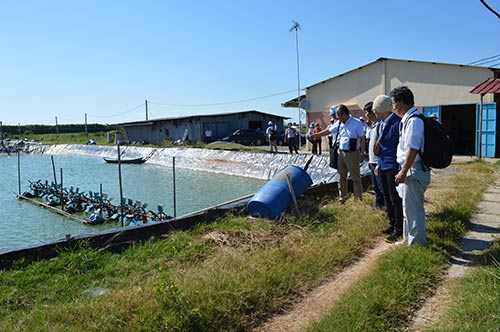
Waste from shrimp ponds is expected to be turned into electricity to serve shrimp farming or the national grid.
 |
| Waste from shrimp ponds is expected to be turned into electricity to serve shrimp farming or the national grid. |
Waste from shrimp ponds is expected to be turned into electricity to serve shrimp farming or the national grid.
A group of scientists from Kyushu University from Japan and the HCM City National University’s Nanotechnology Lab (LNT) have implemented a project on generating power from waste from shrimp ponds in Ben Tre province.
Dr. Dang Mau Chien, the lab’s director, said the biggest challenge for shrimp farmers in Mekong River Delta is the massive death of shrimp caused by unsafe water.
After realizing the problem, the laboratory decided to cooperate with Kyushu University to carry out a project on farming shrimp with Japanese technology under which the waste would be treated to minimize the number of deaths.
LNT is in charge of examining the quality of the water source, while the Japanese side is in charge of thoroughly treating the waste to be discharged during farming.
During the process, the waste from shrimp ponds will be exploited to generate electricity based on fuel cell technology developed by Kyushu University.
Japanese scientists would also join forces with Japanese businesses to build a shrimp hatchery procedure for farmers.
According to Yusuke Shiratori, head of the project team, at first, the scientists tried to focus on treating waste mud to generate electricity. They contacted some enterprises which had suitable technologies such as Magnex, Maywa, Nakayama Iron Works to join the project.
However, later, they found that treating waste mud alone was not enough to help shrimp live. Therefore, he decided to contact more enterprises with advantages in water treatment technology to build a closed shrimp farming procedure.
Japanese specialists plan to build a laboratory near the shrimp farms where there will be sensoring devices which can help supervise the water quality and environment changes.
A storehouse to keep waste mud from shrimp ponds will also be built. The mud, after being collected, will be extracted to get hydrogen which will be used to create electricity with the fuel cell system. The electricity can be used to run shrimp farms, including lighting and oxygen machines.
Fuel cell technology has been widely used to create clean energy resources from biomass.
However, scientists say the SOFC (solid oxide fuel cell) developed by Kyushu University allows electricity efficiency as high as 45 percent, which is much higher than other fuel cells.
(Source: VNN)





